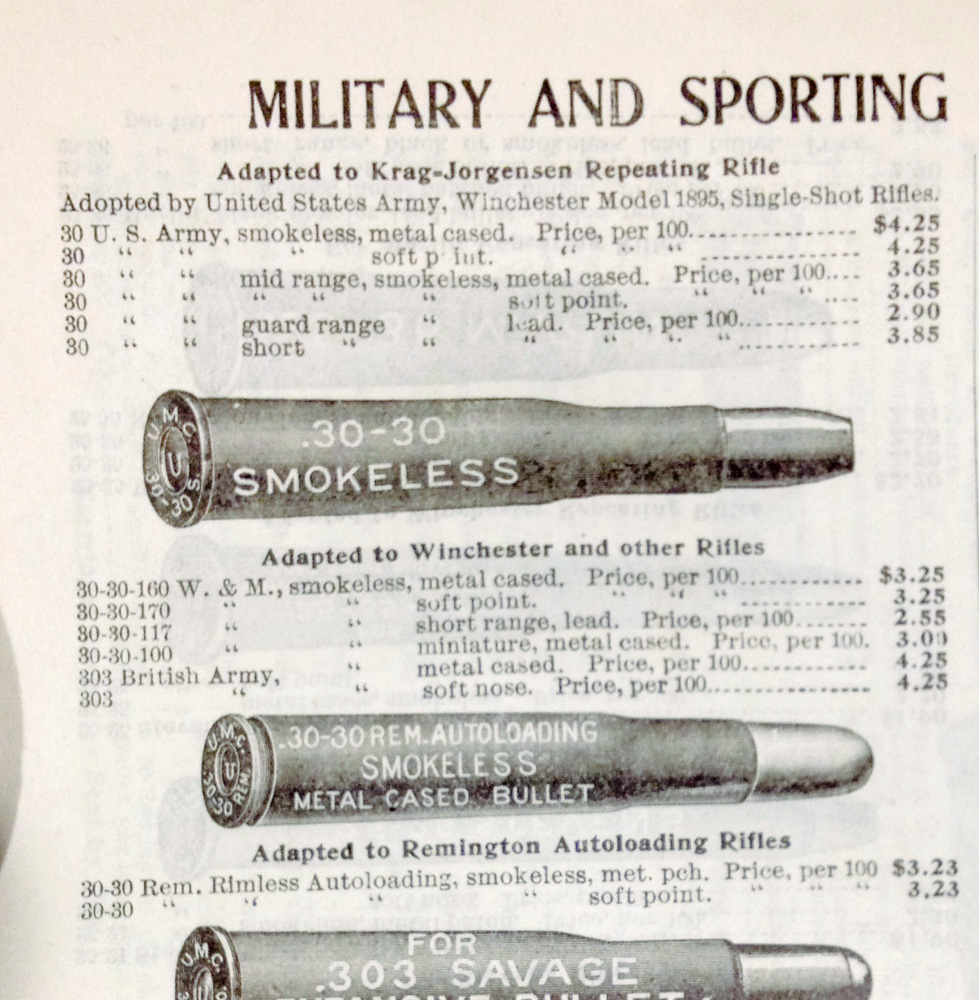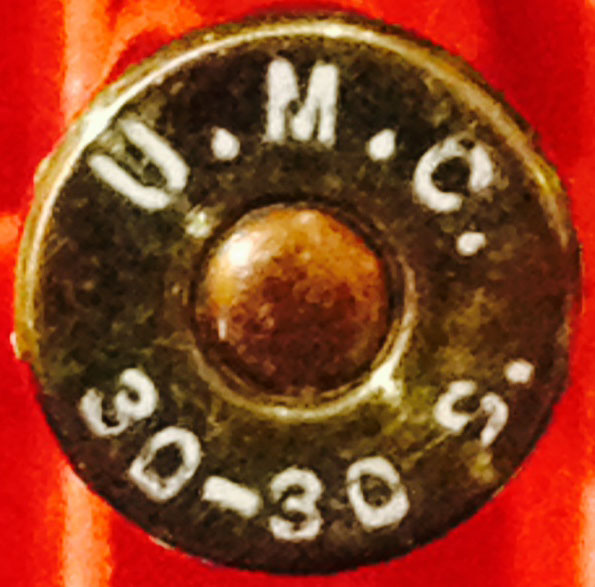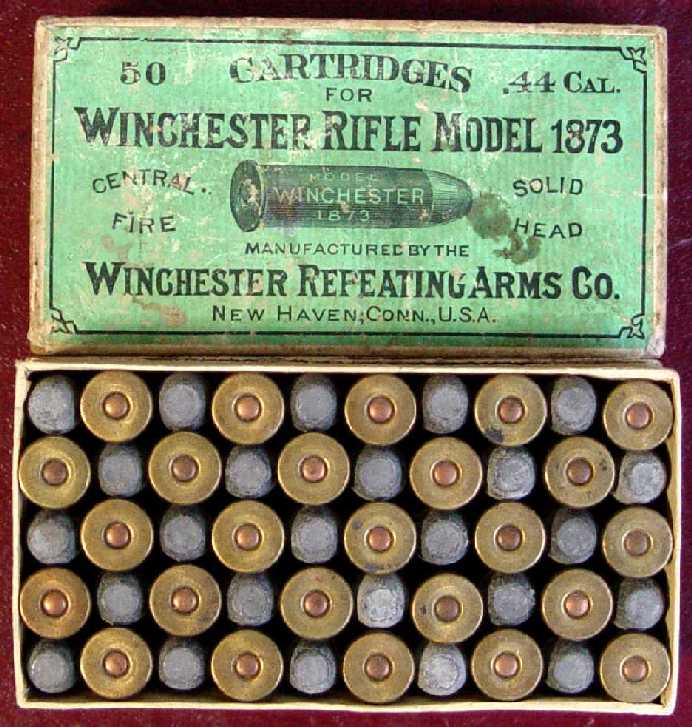|
Return to
Home Page
Email The Old Ammo Guy |
Home of the Old Ammo Guy's Virtual
Cartridge Trading Table
Picture Page
May 2016
Please note: Unless otherwise
indicated, the pictures on this web site are my property, and should not be
used by anyone without my permission.
An unusual .30-30 WCF Cartridge
Last month I included the copy of a page from the 1907 C.
J. Godfrey Company catalog with my write-up on
.30-30 Remington head stamped cartridges. At that time, I noticed the U.M.C.
.30-30 S. head stamp on the cartridge illustrated at the top of the page; the
'S' in the head stamp was apparently intended to identify the cartridge as a smokeless load.

.
.
.
.
.
.
.
.
.
.
.
.
.
Years of collecting head stamp variations have taught me
that cartridge illustrations in catalogs and on cartridge boxes sometimes
can't be trusted, but I recalled having one of these head stamps in
my collection. As it turned out I did, but it was identified as a .30-30 WCF short range
load, which I assume was how it was identified when I first obtained it. The short range loads typically have a high neck cannelure
an
assume was how it was identified when I first obtained it. The short range loads typically have a high neck cannelure
an d this cartridge had none, so I should have suspected that my
identification may have been incorrect. This smokeless head stamp is an
unusual .30-30 WCF variation that isn't likely to be encountered very often
and probably wasn't used after
the merger of Remington Arms and UMC in 1912, if not sooner. What is really odd about
this special head stamp is that the .30-30 WCF cartridge was introduced by
Winchester as a smokeless load, and as far as I know it was only available
factory loaded with smokeless powder from all of the ammunition
manufacturers. Any firearms that were made to chamber the cartridge should
have been made to use smokeless powder cartridges, so
there really shouldn't have been a need for a unique head stamp
to identify it as a smokeless load. In addition, had the .30-30 W.C.F. cartridge
been available loaded with either smokeless or black powder, the 'U' on the
primer in the illustration of the cartridge should have been adequate
to identify the cartridge as a smokeless load. For a period of time following the introduction of smokeless
powder in the early-to-mid-1890s, UMC used these 'U' marked primers on their
smokeless cartridges and unmarked primers on their black powder
cartridges. Other ammunition makers employed this same method of
identification, Winchester using a 'W' on it's smokeless primers, Peters a
'P', and REM-UMC continuing to use the 'U' marked primer after the company
merger. So, to summarize, there really should have been no need for UMC
to have a special head stamp to identify this as a smokeless cartridge, yet
they did as evidenced by the cartridge in my collection. However, their use
of the 'U' marked 'smokeless' primer coupled with the 'smokeless' head stamp
would have been redundant. Note that the cartridge in my collection has an unmarked primer,
an indication that they probably didn't actually use the marked primer with
this head stamp, contrary to what is shown in the illustration. d this cartridge had none, so I should have suspected that my
identification may have been incorrect. This smokeless head stamp is an
unusual .30-30 WCF variation that isn't likely to be encountered very often
and probably wasn't used after
the merger of Remington Arms and UMC in 1912, if not sooner. What is really odd about
this special head stamp is that the .30-30 WCF cartridge was introduced by
Winchester as a smokeless load, and as far as I know it was only available
factory loaded with smokeless powder from all of the ammunition
manufacturers. Any firearms that were made to chamber the cartridge should
have been made to use smokeless powder cartridges, so
there really shouldn't have been a need for a unique head stamp
to identify it as a smokeless load. In addition, had the .30-30 W.C.F. cartridge
been available loaded with either smokeless or black powder, the 'U' on the
primer in the illustration of the cartridge should have been adequate
to identify the cartridge as a smokeless load. For a period of time following the introduction of smokeless
powder in the early-to-mid-1890s, UMC used these 'U' marked primers on their
smokeless cartridges and unmarked primers on their black powder
cartridges. Other ammunition makers employed this same method of
identification, Winchester using a 'W' on it's smokeless primers, Peters a
'P', and REM-UMC continuing to use the 'U' marked primer after the company
merger. So, to summarize, there really should have been no need for UMC
to have a special head stamp to identify this as a smokeless cartridge, yet
they did as evidenced by the cartridge in my collection. However, their use
of the 'U' marked 'smokeless' primer coupled with the 'smokeless' head stamp
would have been redundant. Note that the cartridge in my collection has an unmarked primer,
an indication that they probably didn't actually use the marked primer with
this head stamp, contrary to what is shown in the illustration.
.
.
Return to
Home Page
.

|


 assume was how it was identified when I first obtained it. The short range loads typically have a high neck cannelure
an
assume was how it was identified when I first obtained it. The short range loads typically have a high neck cannelure
an d this cartridge had none, so I should have suspected that my
identification may have been incorrect. This smokeless head stamp is an
unusual .30-30 WCF variation that isn't likely to be encountered very often
and probably wasn't used after
the merger of Remington Arms and UMC in 1912, if not sooner. What is really odd about
this special head stamp is that the .30-30 WCF cartridge was introduced by
Winchester as a smokeless load, and as far as I know it was only available
factory loaded with smokeless powder from all of the ammunition
manufacturers. Any firearms that were made to chamber the cartridge should
have been made to use smokeless powder cartridges, so
there really shouldn't have been a need for a unique head stamp
to identify it as a smokeless load. In addition, had the .30-30 W.C.F. cartridge
been available loaded with either smokeless or black powder, the 'U' on the
primer in the illustration of the cartridge should have been adequate
to identify the cartridge as a smokeless load. For a period of time following the introduction of smokeless
powder in the early-to-mid-1890s, UMC used these 'U' marked primers on their
smokeless cartridges and unmarked primers on their black powder
cartridges. Other ammunition makers employed this same method of
identification, Winchester using a 'W' on it's smokeless primers, Peters a
'P', and REM-UMC continuing to use the 'U' marked primer after the company
merger. So, to summarize, there really should have been no need for UMC
to have a special head stamp to identify this as a smokeless cartridge, yet
they did as evidenced by the cartridge in my collection. However, their use
of the 'U' marked 'smokeless' primer coupled with the 'smokeless' head stamp
would have been redundant. Note that the cartridge in my collection has an unmarked primer,
an indication that they probably didn't actually use the marked primer with
this head stamp, contrary to what is shown in the illustration.
d this cartridge had none, so I should have suspected that my
identification may have been incorrect. This smokeless head stamp is an
unusual .30-30 WCF variation that isn't likely to be encountered very often
and probably wasn't used after
the merger of Remington Arms and UMC in 1912, if not sooner. What is really odd about
this special head stamp is that the .30-30 WCF cartridge was introduced by
Winchester as a smokeless load, and as far as I know it was only available
factory loaded with smokeless powder from all of the ammunition
manufacturers. Any firearms that were made to chamber the cartridge should
have been made to use smokeless powder cartridges, so
there really shouldn't have been a need for a unique head stamp
to identify it as a smokeless load. In addition, had the .30-30 W.C.F. cartridge
been available loaded with either smokeless or black powder, the 'U' on the
primer in the illustration of the cartridge should have been adequate
to identify the cartridge as a smokeless load. For a period of time following the introduction of smokeless
powder in the early-to-mid-1890s, UMC used these 'U' marked primers on their
smokeless cartridges and unmarked primers on their black powder
cartridges. Other ammunition makers employed this same method of
identification, Winchester using a 'W' on it's smokeless primers, Peters a
'P', and REM-UMC continuing to use the 'U' marked primer after the company
merger. So, to summarize, there really should have been no need for UMC
to have a special head stamp to identify this as a smokeless cartridge, yet
they did as evidenced by the cartridge in my collection. However, their use
of the 'U' marked 'smokeless' primer coupled with the 'smokeless' head stamp
would have been redundant. Note that the cartridge in my collection has an unmarked primer,
an indication that they probably didn't actually use the marked primer with
this head stamp, contrary to what is shown in the illustration.